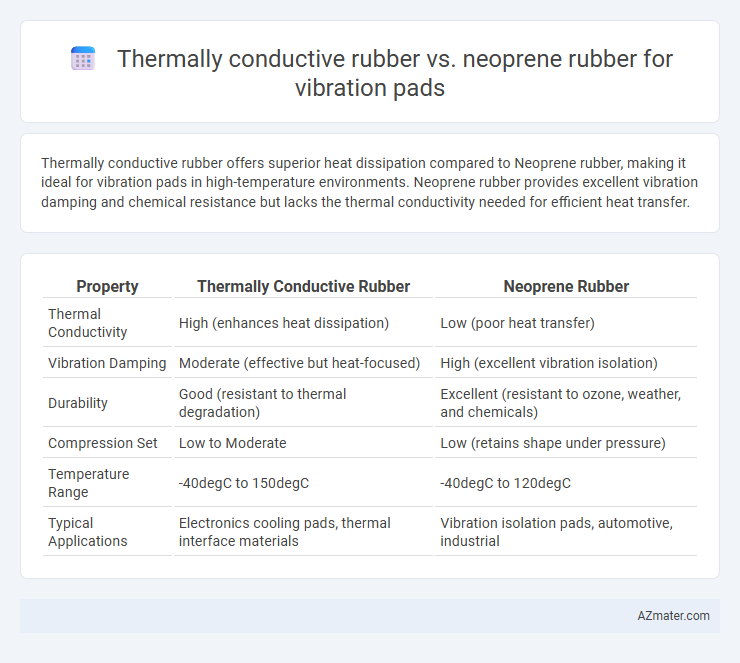Thermally conductive rubber offers superior heat dissipation compared to Neoprene rubber, making it ideal for vibration pads in high-temperature environments. Neoprene rubber provides excellent vibration damping and chemical resistance but lacks the thermal conductivity needed for efficient heat transfer.
Table of Comparison
| Property | Thermally Conductive Rubber | Neoprene Rubber |
|---|---|---|
| Thermal Conductivity | High (enhances heat dissipation) | Low (poor heat transfer) |
| Vibration Damping | Moderate (effective but heat-focused) | High (excellent vibration isolation) |
| Durability | Good (resistant to thermal degradation) | Excellent (resistant to ozone, weather, and chemicals) |
| Compression Set | Low to Moderate | Low (retains shape under pressure) |
| Temperature Range | -40degC to 150degC | -40degC to 120degC |
| Typical Applications | Electronics cooling pads, thermal interface materials | Vibration isolation pads, automotive, industrial |
Introduction to Vibration Pads
Vibration pads made from thermally conductive rubber offer superior heat dissipation while effectively isolating mechanical vibrations, making them ideal for applications requiring both thermal management and vibration control. Neoprene rubber vibration pads provide excellent durability, resistance to oils and weathering, and good vibration damping properties, commonly used in heavy machinery and automotive sectors. Choosing between thermally conductive and neoprene rubber depends on the specific needs for thermal conductivity versus environmental resistance in vibration isolation.
Importance of Material Selection
Material selection for vibration pads critically impacts thermal management and damping efficiency, with thermally conductive rubber offering superior heat dissipation compared to standard neoprene rubber. Thermally conductive rubber incorporates fillers like aluminum oxide or boron nitride, enhancing thermal conductivity up to 5 W/m*K, essential for applications requiring heat transfer alongside vibration isolation. Neoprene rubber, while effective for general vibration damping and chemical resistance, provides limited thermal conductivity (around 0.2 W/m*K), making it less suitable for high-temperature environments.
Overview of Thermally Conductive Rubber
Thermally conductive rubber offers superior heat dissipation properties compared to standard neoprene rubber, making it ideal for vibration pads in electronic and industrial applications where temperature management is critical. This material combines flexibility and durability with enhanced thermal conductivity, ensuring effective vibration isolation while preventing overheating. Its formulation typically includes thermally conductive fillers such as silica or boron nitride, which significantly improve thermal transfer without compromising the rubber's damping performance.
Overview of Neoprene Rubber
Neoprene rubber offers excellent vibration damping properties due to its resilient and flexible molecular structure, making it a popular choice for vibration pads in industrial and automotive applications. Its moderate thermal conductivity is lower than thermally conductive rubber, which primarily limits its use where heat dissipation is critical but enhances its insulation capabilities. Neoprene's chemical resistance to oils, solvents, and weathering further extends its durability and performance in harsh environments compared to thermally conductive rubber variants.
Thermal Conductivity Comparison
Thermally conductive rubber exhibits significantly higher thermal conductivity values, typically ranging from 1.0 to 5.0 W/m*K, compared to neoprene rubber's lower range of 0.15 to 0.35 W/m*K, making it more effective for heat dissipation in vibration pads. This enhanced thermal conductivity enables thermally conductive rubber to efficiently transfer heat away from sensitive components, reducing thermal buildup and improving overall vibration pad performance. Neoprene rubber, while offering good vibration damping and chemical resistance, is less suited for applications requiring efficient thermal management due to its inferior heat transfer capabilities.
Vibration Damping Performance
Thermally conductive rubber exhibits superior vibration damping performance compared to neoprene rubber due to its enhanced material composition that effectively dissipates vibrational energy and reduces resonance frequencies. Neoprene rubber offers moderate vibration isolation but lacks the specialized thermal conduction properties that aid in stabilizing temperature fluctuations, which can impact damping efficiency. Selecting thermally conductive rubber for vibration pads ensures improved durability and consistent vibration attenuation in high-heat environments.
Durability and Lifespan
Thermally conductive rubber offers enhanced durability for vibration pads by efficiently dissipating heat, reducing thermal degradation and extending lifespan compared to Neoprene rubber. Neoprene rubber, while resistant to oils and weathering, tends to degrade faster under high thermal stress, leading to a shorter functional lifespan in vibration isolation applications. Selecting thermally conductive rubber ensures longer-lasting vibration pads especially in high-heat environments, maintaining structural integrity and optimal vibration dampening over time.
Application Suitability
Thermally conductive rubber excels in applications requiring efficient heat dissipation alongside vibration damping, making it ideal for electronic equipment and machinery that generate significant heat. Neoprene rubber offers excellent resilience and chemical resistance, suited for general-purpose vibration pads in automotive, industrial, and marine environments. Choosing between these materials depends on the need for thermal management versus broader environmental durability and resistance.
Cost and Availability
Thermally conductive rubber typically costs more than neoprene rubber due to its specialized materials and manufacturing process designed for enhanced heat dissipation. Neoprene rubber is widely available and more cost-effective, making it a popular choice for vibration pads in budget-sensitive applications. The availability of thermally conductive rubber is limited compared to the mass production and broad distribution channels of neoprene rubber, impacting lead times and procurement costs.
Final Recommendation
Thermally conductive rubber offers superior heat dissipation and vibration damping, making it ideal for applications requiring both thermal management and shock absorption in vibration pads. Neoprene rubber, while providing excellent chemical resistance and durability, lacks the thermal conductivity properties necessary for high-heat environments. For vibration pad applications demanding effective heat transfer alongside vibration isolation, thermally conductive rubber is the preferred choice.

Infographic: Thermally conductive rubber vs Neoprene rubber for Vibration pad
 azmater.com
azmater.com